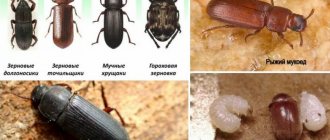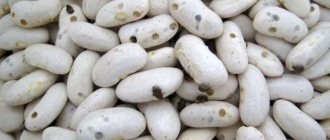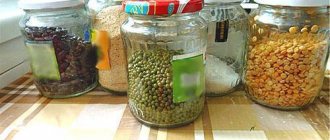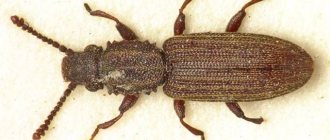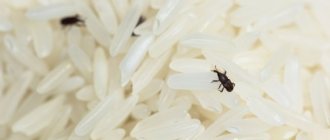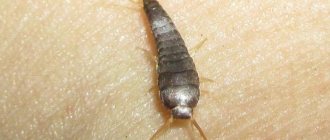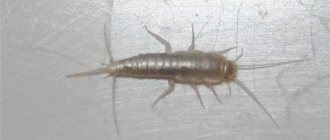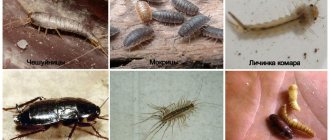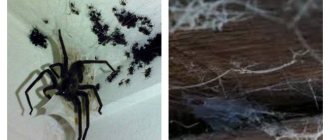If there are bugs in the cereals, then urgently take measures to combat them. Read more in the article.
Those who like to stock up on cereals, flour and other products for future use often encounter this problem. Insects are noticed on the shelves of cabinets in the kitchen; cobwebs with adhered grains and small particles of debris appear in bags of bulk products, which looks quite unpleasant.
Read an article on our website about the calorie content of cereals . You will learn which grains you can eat while losing weight and which you shouldn’t.
What kind of attack is this? What to do if there are bugs in cereals? Read this article below.
What are the names of the bugs that appear in cereals?
Bugs that appear in cereals
As mentioned above, housewives often encounter a similar problem. What are the names of the bugs that appear in cereals? These can be several types of insects:
The red Surinamese mucoed eater appears in cereals
- The red Surinamese mucous beetle is a small up to 3 mm with brown or light brown hard wings. It also feeds on dried fruits, cereals, grains, and dry medicinal herbs. At subzero temperatures, these bugs, their larvae and laid eggs can live for 2-3 weeks .
Flour beetle infests in cereals
- The flour beetle is a small black bug, very active and viable, with powerful jaws capable of chewing through food packaging. Its larvae, known as mealworms, pose the greatest danger, destroying large quantities of flour and other products if they are not detected in time. Loves dark, damp places in the kitchen and pantries.
Rice weevil infests in cereals
- The rice weevil is a bug up to 3.5 mm long, dark brown or dark brown in color. It has a highly elongated head with strong jaws. He eats not only cereals, but loves tea, paper, bread crumbs, dried fruits, and nuts. More heat-loving than other pests. Dies in sub-zero temperatures within a week.
The bread grinder starts in cereals
- The bread grinder is a flying brown bug up to 3 mm . up to 300 eggs in its life . He eats not only bread - he loves pasta, animal food, cookies, book covers.
Why do foods contain such insects? Read on.
Why do black and brown bugs appear in cereals: reasons for their appearance
Bugs in cereals
Many housewives often have questions: “Why do black and brown bugs appear in cereals?”, “What are the reasons for their appearance?” Here is the answer:
- Insects are usually brought from the store with purchased products.
- Even your neighbor, without knowing it, could lend you contaminated cereals or flour.
- Also, amateur fishermen specially breed mealworms to use them as bait.
Worth knowing: The pests themselves do not travel long distances, only along with packaged products.
It's hard to see them in the store because they are so small. In addition, there may be larvae in the cereal or flour - they are not visible at all.
But how do they get into store packages? The reason lies in non-compliance with storage rules and weakening of sanitary control in production. To preserve food in warehouses, minimum air humidity is required. If this indicator is violated and the humidity is 50% or higher , then the risk of insect damage greatly increases. Moreover, if they are packaged not in small containers, but in bags with the subsequent sale of products by weight.
Insects appeared in bulk products
Infection with flour bugs occurs due to non-compliance with the conditions of production and storage of flour or cereals. In this case, there is often an increase in humidity levels and insufficient quality of product processing. Usually the critical limit of humidity is considered to be 14%. At higher values the beetle may get infested.
Most often, loose flour becomes infected, since it is stored in the open air, which means that pests can lay eggs. It is almost impossible to determine the presence of larvae, since they develop inside small white shells. For this reason, it is recommended to purchase factory-packaged products. However, there is also a risk that flour bugs will appear, since some types of insects gnaw not only products with a dense structure, but also the walls of plastic packaging.
If they are severely infested with flour beetles, they should be thrown away, as eating them is dangerous to health.
How to get rid of food bugs in cereals: methods, folk remedies
Bugs in the croup
If even one bug catches your eye, then you need to act immediately, without putting the matter off for a long time. It is quite possible that all the cereals are already infected with larvae and in a few days there will be hundreds of times more of them. How to get rid of food bugs in cereals?
It is quite difficult to completely get rid of them, but you still need to do everything possible to destroy them. What needs to be done? Here are effective ways:
- Review all supplies , find the source of infection and all affected products, and if there are a lot of bugs, the best solution is to throw away all the cereals and flour without regret.
- If there is a slight infection, you can try to save the cereals - put them in the freezer for at least a week or place them in a hot oven at a temperature of about 50°C for 2-3 hours (without packaging).
- If all else fails, you will have to use chemistry . The best remedy for killing bugs is D ichlovos. This product is smelly and harmful to our health. Therefore, you need to take precautions when working with this drug; they are indicated on the packaging. There are other drugs, for example, Raptor .
There are also folk remedies to combat these pests. A good alternative to dichlorvos is camphor alcohol , which also has a very strong smell, but is not so harmful.
- Before using it, you need to put the flour, which strongly absorbs all odors, into a tight bag and tie it well. You need to do the same with the rest of the products.
- Place napkins moistened with camphor alcohol in the corners of the cabinet.
- Also put them on shelves in the corners and close the doors for 3 hours . You need to do this 3-4 times a week until the bugs disappear completely.
Pest control is good, but ongoing prevention can be done to ensure the insects never get infested. Read more below.
Chemicals
If the beetle has infected all the products, then it is much more advisable to treat the infected room with insecticides. Below are the drugs that are used to combat small and large flour beetles.
Phosphine
A gas produced by mixing phosphorus with hot alkali. In agricultural stores it is sold in the form of blocks for fumigation, containing substances that synthesize this chemical element when heated.
Phosphine affects the nervous system and disrupts the metabolism of insects, including the flour beetle. It is also effective against other pests.
Expert opinion
Mityuk Stefania Bogdanovna
The connection is also dangerous for humans. During the fumigation of the room, you must leave it and return only after 10 - 12 hours. The treatment area must be well ventilated.
Borax
Relatively safe product. Effective against adults, but not against larvae. Borax is mixed with flour and sugar and placed in areas where the parasite is expected to live. When ingested by a beetle, the substance causes severe dehydration, resulting in death.
Ozone
Flour beetles do not tolerate air saturated with ozone. Therefore, ionizers are used to combat them. They are left on for several hours in the room being treated.
Ozone is also toxic to humans. Therefore, the room must be well ventilated before using it.
Insecticide solutions are also used against the beetle. However, it is strictly forbidden to use them for food processing - you can get poisoned. Using solutions, the pest is removed from the seed.
How to properly store flour and cereals to prevent bugs from getting in?
This is not the right way to store flour and cereals.
As mentioned above, for proper storage you need to ensure low air humidity. Bugs need moisture to survive, and if there are damp places in the kitchen, you won’t have long to wait for pests to appear. How to properly store flour and cereals to prevent bugs from getting in? Here are some tips:
CLEANING:
- If there are corners in the cabinets where bread crumbs or grains of food are lying around, reproduction will be very fast.
- Therefore, housewives should keep kitchen furniture clean and dry.
- Do general cleaning and ventilate cabinets more often.
Linen bags for storing cereals
STORAGE IN SPECIAL BAGS . There is one interesting way to store flour, but you need to try and do the following:
- Sew bags from thick linen fabric, place them in a strong salt solution and, without rinsing, let them dry.
- In such a “salty” container, no insects are afraid of flour.
- Other bulk products can also be stored.
DO NOT STORE IN:
- For better preservation of flour and cereals, do not constantly keep them in store packaging.
- It is better to pour into glass or plastic containers with tight-fitting (preferably screw-on) lids.
- This storage method will prevent further spread of insects.
CHEWING GUM WITH MINT:
- Another good bug repellent is chewing gum with a strong minty scent.
- Place unwrapped pieces of gum in the corners of the cabinet.
- The product does not work 100% , but with a small infestation it will help curb the growth of pests.
DO NOT STOCK:
- You shouldn't stock up on large amounts of food.
- Flour and cereals are inexpensive, and you can always buy them in the store.
- Thanks to this, you will use fresh products from the store, and not those that have been stored for six months at home and the packages may already have worms or bugs.
Storing cereals closed STORE
GREATS CLOSED:
- Another simple way to store bulk products is that you don’t need to store them open.
- If they are in store packaging, close it with at least a clothespin or paper clip.
- Do not open a new packet of cereals or flour until the old one is gone.
Our mothers and grandmothers, when storing cereals and flour, put different smelling products in containers - garlic, lavender sprigs, clove buds, etc. Some helped, but some didn’t. Now housewives also use such methods. Read more below.
Fighting mucoeds at work
Eliminating the possibility of mucoid occurrence is the main task of food sector companies. Grain storage facilities and production facilities are treated with special chemicals.
In addition, methods of heating, cooling and cleaning grain are used; grains are thoroughly dried and stored at low temperatures. This helps prevent the bug from appearing.
Quality departments monitor the purity of each batch of products sent to the counter. However, an unfair attitude towards this stage of production is present and bears fruit - bugs appear in the customers’ kitchen and infect other products.
What to put in cereals to prevent bugs from infesting them: remedies
Garlic and bay leaves can be placed in cereals to prevent bugs from infesting them.
Of course, the refrigerator is not exactly the place where cereals and flour will be stored constantly, it is inconvenient. Therefore, you can try to get rid of bugs using strong-smelling products. It was said above that in ancient times, women used such methods. Modern housewives also often resort to similar methods. What to put in cereal to keep bugs away? Here are the means:
- Bay leaf - this can be periodically rubbed between your palms to enhance the scent.
- Garlic - several cloves are placed in jars with bulk products, having previously cleared it of the covering husk. But there is no need to cut off the very top of the clove.
- Chamomile-pyrethrum powder (found at pharmacies). This plant is capable of expelling not only bugs, but also mice from the room.
- Dried marigold flowers - they need to be changed periodically so that the smell does not fade.
- The aroma of lavender is also good at repelling insects. It is necessary to place cotton pads or paper napkins soaked in lavender oil on the shelves in the closet.
- Powdered nutmeg will help you forget about pests in your kitchen cabinets for a while.
- Various metal objects help in getting rid of insects - nails (only large ones; small ones can be accidentally put into a pan with cereal), wire, new metal lids for seaming.
Wrap jars where cereals and flour are stored with foil. This method may seem strange, as with metal objects, but it is effective.
Bugs in cereals: what harm can they cause to health?
Bugs in the croup
Bugs leave behind fragments of their shells, excrement, dead eggs or larvae in the croup, which are not digested in the human stomach and can cause inflammation or irritation of the stomach. What other health risks could there be?
- Products infected with bugs, even if they have undergone heat treatment, significantly lose their taste.
- Ready-made dishes made from them look completely unappetizing.
- In addition, all this can cause an allergic reaction in a person prone to this disease.
- In case of severe contamination, when there is a lot of excrement in the food, food poisoning is even possible.
- If the bugs were not detected in time, and such products were eaten in large quantities for a long time, serious health problems may arise. Microbes that are dangerous to the human body thrive in the waste products of these insects.
So can you eat contaminated cereals and flour and should you throw it away? Read on.
There are bugs in the cereal: can it be eaten?
There are bugs in the cereal.
For very squeamish people, such a question does not even exist. They mercilessly throw away food spoiled by bugs and do the right thing. So, there are bugs in the cereal, can you eat it?
- Infected cereals are unlikely to be edible, even if all the bugs are removed.
- The products contain larvae or eggs that are invisible to the eye, excrement, and pieces of the chitinous covering of insects.
- Such food does not evoke very pleasant feelings from an aesthetic point of view.
By the way, pests prefer millet among all cereals, probably due to the fact that it contains a high percentage of fat. Therefore, lovers of millet porridge should be especially careful when purchasing this cereal.
How to treat a cabinet from bugs in cereals?
Cabinets must be treated to prevent bugs from infesting cereals.
Even if all contaminated products have been destroyed, larvae or eggs of pests may remain in cabinets in corners and crevices. How to treat a cabinet from bugs in cereals?
- Using a special long and narrow brush of a vacuum cleaner, you need to clean all inaccessible places.
- Rinse the entire cabinet well with a solution of laundry soap, then wipe with a clean damp cloth and dry the cabinet thoroughly, airing it for at least a day.
- Then go over again with a cloth moistened with slightly diluted 9% vinegar and ventilate again.
- If possible, it is preferable to dry cabinets outdoors under the scorching rays of the sun. Ultraviolet light will be an additional means for killing bugs.
- Washed cabinets can be additionally dried with a hairdryer, directing a stream of hot air to the most vulnerable places - corners, cracks, chips in the surface of the furniture.
Controlling these insect pests is much more difficult. Therefore, it is better to carry out preventive measures to prevent their appearance and reproduction. Good luck!
Where does flour beetle come from in an apartment?
The main way for a beetle to enter an apartment is to purchase products that have already been contaminated. Surely you have had a situation where, after buying groceries, you open the package, and there are larvae or bugs swarming around there. Infection occurs in warehouses and storage facilities when storage rules are not followed.
The large beetlefish feels good in the attic with pigeons, lives and reproduces, as it can feed on animal substances, such as the remains of feathers. Once in a multi-storey building with the help of birds, where the beetle cannot find a suitable place for breeding and food, it enters the apartments through the ventilation shafts.
